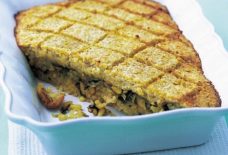Gordon Ramsay Treks the Mountains of Morocco
With help from Moroccan locals, Gordon dives into the food culture and ancient traditions of the indigenous Amazigh (Berber) people.
SOURCE: NATIONAL GEOGRAPHIC
BY: JILL K. ROBINSON
For some, mushroom foraging is little more than a walk in the woods. Not so for Gordon Ramsay, who’s donned a climbing harness in Morocco’s Middle Atlas Mountains to rappel down the length of a waterfall into a canyon. “I’m a big adventurer and I love mushrooms,” he says. “But that’s the scariest descent I’ve ever done for a mushroom.” Proclaiming himself “king of the mushrooms,” local mushroom hunter Abdullah leads Ramsay to a basket he’s packed with the bounty of the area over the past couple days of foraging.
Over the centuries, Arab, Ottoman, Spanish, and French cultures have left their mark on the cuisine of the indigenous Amazigh (Berber) people. “Every bite is steeped in history,” says Ramsay, as he visits Fez, the country’s culinary capital, to take a deep dive into the food culture of the Berbers. While the Atlas Mountains and Berber culture form the backbone of Moroccan food, and other cultures have added flavours over time, contemporary chefs like Najat Kaanache are changing the face of the country’s cuisine at her restaurant, Nur.
Gordon Ramsay learns traditional culinary methods in Morocco with assistance from his nine-year-old “sous chef” Fatima.
PHOTOGRAPH BY NATIONAL GEOGRAPHIC/MARK JOHNSON
For newcomers who gaze across the Moroccan landscape, it’s difficult to immediately understand how much grows here. “Berber land is where the people still have the traditions and the way of cooking,” says Kaanache. In rural life, attachment to the land is key, and Moroccans gather what grows wild around them, lending native flavours to any dish—no matter its origins. Traditional Berber cuisine draws from Morocco’s Atlas Mountains and other heavily populated Berber cities and regions, but differs from one area to another across North Africa.
Abdullah and his crew show Ramsay how to incorporate the basket of morel, porcini, and chanterelle mushrooms into medfouna, a stuffed bread they refer to as Berber pizza. The word medfouna means “buried,” referring to the delectable blend of ingredients and spices hidden within the bread crust. Cooked in the outdoors over a campfire, it seems an added luxury to incorporate these expensive mushrooms in everyday cuisine, but the forests of Morocco conceal a wide variety of edible, wild mushrooms.
“Did you rappel down a waterfall with your hands to get them? I don’t think so,” says Ramsay as Kaanache adds wild foraged mushrooms to one of her dishes at the Big Cook in a Berber village during their Yennayer (new year) celebration. As is his focus in Uncharted, Ramsay dives deeper into Berber tradition and trades some of his foraged heart of palm for local honey with the help of his village sous chef, 9-year-old Fatima, who leads him to her grandmother’s house to find the final ingredient of the day.
Left: Cooking under way for a Moroccan New Year celebration.
Right: Caramelised carrots, made with locally sourced honey, cook on the open stove.
PHOTOGRAPH BY NATIONAL GEOGRAPHIC/MARK JOHNSON
While having claimed he felt like a fish out of water with some aspects of Berber cuisine, Ramsay and Kaanache prepared their dishes outdoors—grilling or slow cooking over hot coals. “I’ve been humbled by these people’s incredible hospitality. I’ve learned techniques that go back centuries, and been reminded that you don’t need a fancy kitchen to produce truly outstanding cuisine,” says Ramsay.
Lead Image: Gordon Ramsay rappels down a mountain in the Middle Atlas region of Morocco to meet a local mushroom hunter.
PHOTOGRAPH BY NATIONAL GEOGRAPHIC/MARK JOHNSON
This article was produced by National Geographic Channel in promotion of the series Gordon Ramsay: Uncharted.









